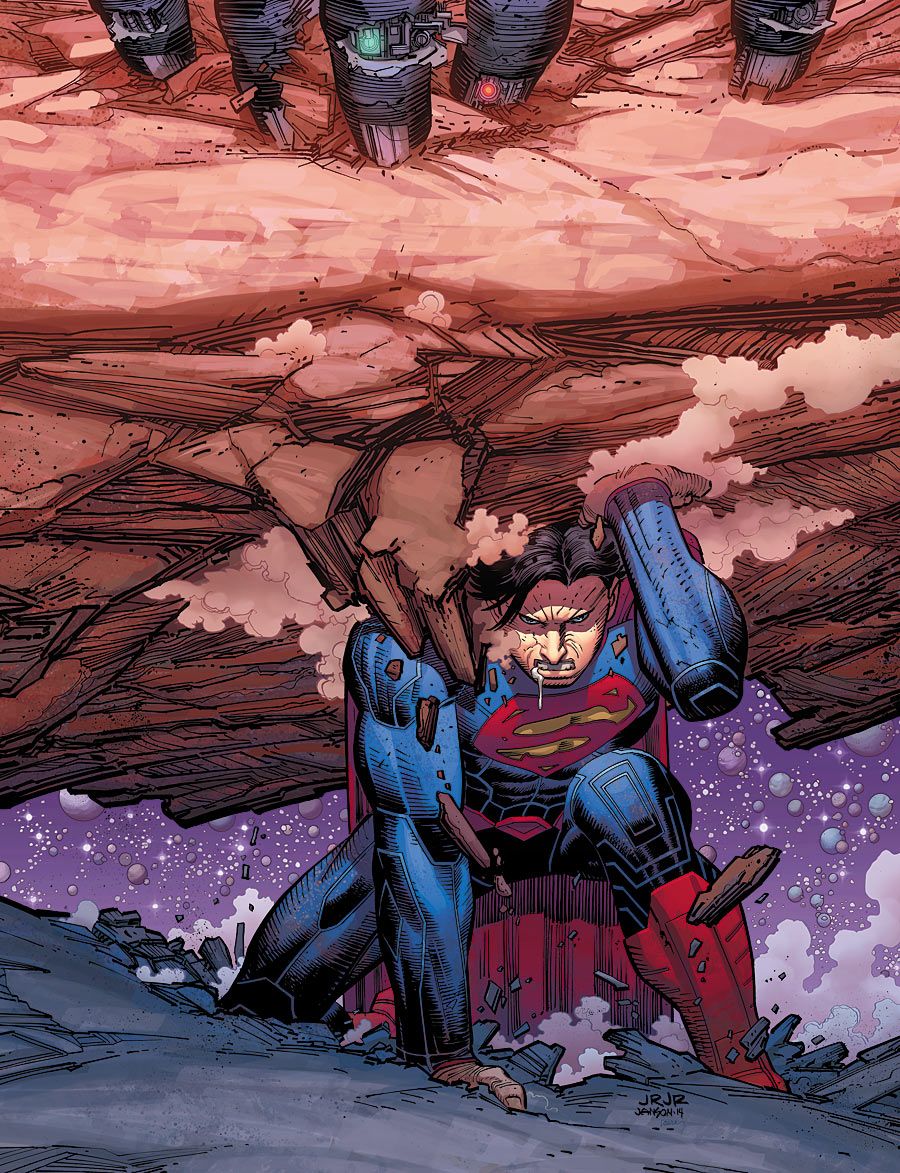Nearly three years into DC Comics' New 52 relaunch, Chief Creative Officer Geoff Johns steps in and takes direct control of the company's flagship character, assuming the writing duties beginning with this week's "Superman" #32, the title's fifth ongoing writer since the relaunch. In an equally high-profile move, artist John Romita Jr., primarily associated with his Marvel work over the past three decades, moves over to DC to draw the Man of Steel for the first time, pencilling Johns' story with veteran artist Klaus Janson handling the inks. Without disavowing anything that's come under previous creators, Johns and Romita immediately make a bold statement at the very start of this issue, before Big Blue even appears, reminding readers that this isn't just another comic book about an everyday superhero; this is a story about Superman, and they make sure readers know it.
The introductory sequence carries a very familiar and obvious similarity to Superman's own origin, in a sequence that serves both as the aforementioned reminder, and also kicks off the issue with a dramatic doomsday-like scenario (not that Doomsday) which is explained as the scene unfolds. It's familiar, yes, but not derivative, as there enough key differences to evoke interest and stave off any sense of repetition. Romita, on the very first panel in fact, makes sure readers know that this seemingly-apocalyptic scenario is taking place right here on Earth, while colorist Laura Martin exclusively applies red and blue tones to the entire five-page sequence, which visually keeps readers rooted to the original story of baby Kal-El while Johns and Romita simultaneously tell the story of two parents and their newborn son who they selflessly make every effort to save.
This first act, conservatively staged by Romita at five to six traditionally-styled panels per page, is cleverly set up to give readers a knockout punch when they turn the page. Here they find perhaps the boldest statement of the issue: the Superman readers have wanted since The New 52 began is back, and Romita magnificently shows them exactly that in the form of a double-page spread with The Man of Steel taking it to an imposing but decidedly-weakened Titano.
The battle is joined near its end, which has no bearing on the story as its intent is solely to provide a showcase for what to expect with Romita's take on Superman, which is impressive, and for many DC fans there's no better way to do that than against one of its gorilla characters. Romita acknowledges that this is indeed new incarnation of Superman; the costume tweaks are evident, but they are drowned out in Romita's iconic pose that captures the character's essence first, and the trappings second.
When things settle down, it's in a deliberately familiar and welcome setting, with not only the usual but always-fun don't-call-me-chief type banter between Jimmy Olsen and Perry White, but also Perry trying to woo Clark back to the Daily Planet. This scene plays into the current situations of both Clark and Jimmy, while also acknowledging that a return to the traditional status quo isn't out of the question. Johns and Romita then roll into a funny but revealing look at the disparity between Clark's private life and those of his friends, where Jimmy deals with lawyers, Lois endures come-ons from Steve Lombard, while Clark touches base with his pals in the Justice League.
Having established the tone of the book and the feel of the character, Johns and Romita move on to the main story, centering on the Man of Tomorrow's encounter with a new villain and then subsequently with Ulysses, another new character that ties into the comic's opening scene. Ulysses' powers, attitude, and feelings of isolation demonstrate some very clear parallels to Superman's own history and the basis for the title of this issue's story, "The Men of Tomorrow." Romita uses a number of additional single and double-page panels here, but none of them are wasted, although the final one, on the story's last page, could be construed as excessive. One provides a dynamic intro for Ulysses' character, and the next makes for a crowd-pleasing collaboration between not only the two characters, but also between Romita, Janson, and Martin.
Romita's sharp, almost Infantino-esque style isn't one that comes to mind when one thinks of likely Superman artists, but his storytelling skills and ability to cinematically envision a script are what make him a superb choice for this comic. It's similar to a scenario decades ago, when longtime Marvel creator Jack Kirby moved to DC and took over "Superman's Pal, Jimmy Olsen," which was welcomed by many fans but looked upon dismay by others, but regardless gave Superman a look that was unlike anything the character had seen before.
"Superman" #32 doesn't make any apologies for what led to this creative takeover, nor does it need to. Instead, it just tells an excellent story that speaks for itself, and captures both the nature and the scope of the character. Johns and Romita deliver the kind of Superman story that readers want, and give the franchise a kind of pseudo-reboot that was sorely needed.

